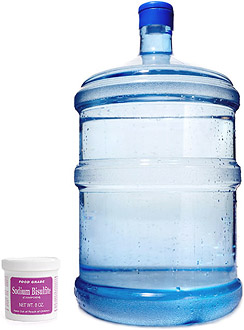 Hello:
Hello:
I recently read an article on your website that said not to use distilled water, but bottled water labeled spring water. Should I treat the water with sodium metabisulfite before beginning the primary fermentation in my plastic fermenter or is the bottled spring water okay to use straight from the bottle?
-Shawn S.
———-
Dear Shawn,
Deciding if you should add Sodium Metabisulfite before the fermentation or not isn’t determined by the type of water you use. Regardless if it is bottled spring water or just plain tap water, it does not make a difference. Either water is fine and does not require the addition of sulfites.
What does matter is whether or not you are making wine from fresh fruits. When making wine from fresh fruits, sulfites should be added before the fermentation to destroy any wild molds, bacteria, etc. If you are making wine from a packaged wine making juice of some kind, then there are no wild molds or bacteria to be delt with, so no sulfites are needed.
Sodium Metabisulfite is added 24 hours before you add the wine yeast. During this time the sulfites release into the must and then slowly disipate into the air. This is why you only want the fermenter to be covered with nothing more than a light towel. Once 24 hours has past, you can then add your wine yeast. If you add the yeast before this time, you run the risk of killing the yeast with the sulfites.
Best Wishes,
Customer Service
———————————————————————————————————
Ed Kraus is a 3rd generation home brewer/winemaker and has been an owner of E. C. Kraus since 1999. He has been helping individuals make better wine and beer for over 25 years.
Category Archives: Q&A
Questions About Bottling Homemade Wine
 Hello
Hello
My name is Rachelle–my boyfriend and I are hobby wine makers and recently discovered your website last fall–WE LOVE IT 🙂 We do have a question, however, regarding the proper technique during bottling that we can’t seem to find a straight answer to.
We have been bottling directly from our wine filter, and are first wondering if that is okay, or if we should let the wine sit a few days after filtering before bottling?
The second question, should we try to minimize the amount of “bubbling” during bottling. I mean should we try to bottle by allowing the wine to gently fill down the side of an angled bottle so that there is little surface disruption/aeration, or if we can just point the hose down, shoot and fill it up so there is oxygen mixed with the newly bottled wine.
If you could please let us know, it would be greatly appreciated. We have a few more weeks until our next bottling, but would like the input. Thank you kindly.
Sincerely,
Rachelle
———-
Dear Rachelle,
Both of your questions can be answered with the same reasoning: you never want to splash a finished wine in a way that allows air to saturate into it. This is particularly important when learning how to make white wines. Air is the fuel for oxidation, a condition that can cause a wine to turn brown or orange. In the case of white wines oxidation is easily noticeable, but it can also be troublesome for reds.
Relating this issue back to your question about bottling homemade wine straight from the wine filter, doing so is very difficult to do in a gentle way. Wine is more easily wasted with this method as you move from one bottle to the next, and splashing is certainly more prevalent.
It is much better to transfer the wine from the wine filter to something like a plastic fermenter that has a spigot. Once you are done filtering the wine you can attach a piece of vinyl hose to the spigot and start filling the bottles from there.
Regarding your second question about how to get the wine into the wine bottles, the ultimate way is to fill the wine bottle from the bottom up. In the instance of using a piece of vinyl hose attached to a spigot, shove the hose all the way to the bottom of the wine bottle when filling. The idea is to keep the end of the hose down into the wine. This will eliminate virtually all the splashing. You can turn the spigot off between bottles to save making a mess.
We do have additional wine making products that make bottling homemade wine a little easier. One of them is a filling rod that can turn the flow off automatically between bottles. It’s call a Bottle Filler. It’s a long piece of clear, rigid tubing that fits on the end of the vinyl hose, like a wand. The other end has a button on the end that you press against the bottom of the wine bottle to start the flow. Once you lift up on the bottle filler, the flow automatically stops.
I hope this information is what you where looking for, Rachelle.
Happy Wine Making
Customer Service at E. C. Kraus
———————————————————————————————————
Ed Kraus is a 3rd generation home brewer/winemaker and has been an owner of E. C. Kraus since 1999. He has been helping individuals make better wine and beer for over 25 years.
A Stirring Question About Wine Making
 Hi E.C.,
Hi E.C.,
I’m making my first wine ever with your starter kit and my own wild grapes. I have your plastic fermenter that came with the kit, but I bought one of your glass jugs for secondary. I just started the secondary fermentation and I am not sure if I should continue to stir daily. I assume once the air lock is on I should just leave it alone?
Thanks,
Luke
———-
Dear Luke,
Once all the wild grape pulp has been removed from the fermentation, there is no need to stir the fermentation daily. Removing the pulp is something you should have done when you moved the fermentation from your plastic fermenter into the 5 gallon glass carboy for secondary fermentation. This is done simply by syphoning the wine into the secondary container and leaving the pulp and sediment behind. This is a process called racking.
The purpose of stirring the fermentation is to make sure that the pulp does not form a dried cap on the surface of the liquid. The dried cap can interfere with the wine yeast’s supply of oxygen, making it hard for the yeast to multiply itself into sufficient numbers. By stirring daily, any cap can be broken up and mixed down into the juice. In the secondary fermentation there is no pulp and therefor no reason to stir.
Best Wishes,
Customer Service at E. C. Kraus
———————————————————————————————————
Ed Kraus is a 3rd generation home brewer/winemaker and has been an owner of E. C. Kraus since 1999. He has been helping individuals make better wine and beer for over 25 years.
Help! My Corks Are Popping Out!
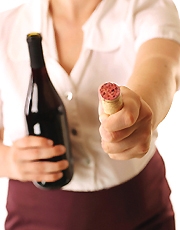 Good Morning:
Good Morning:
First I would like to thank you for the newsletters. I have been receiving them now for about 2 years and they have come in very helpful and I have been making wine for at least that long.
The question I have is, when bottling I put the amount required for bottling of campden tablets and sometimes I will still have bottles that will pop out the corks and I use #9 corks. I was wondering if I was doing something wrong or is there something else that I need to do.
Thank You
Nancy
———-
Dear Nancy,
While Campden Tablets will reduce the chance of popping wine bottle corks, it is far from a guarantee. Campden Tablets are primarily added to keep the wine fresh and to help it retain its color. It is Sodium Metabisulfite in tablet form.
The problem you are experiencing is more than likely being caused by either: (1) not allowing the fermentation complete all the way before bottling, or (2) you added sugar after the fermentation to sweeten the wine, but did so without adding a wine stabilizer [Potassium Sorbate].
In the future, before bottling you need to check the wine with a gravity hydrometer to make sure your specific gravity reading is .998 or less. This will confirm that the fermentation has completed and is ready for Campden Tablets to be added. If the fermentation decides to start again while in the wine bottle, pressure will build and corks will pop.
If you add sugar to the wine before bottling to increase its sweetness, it is important that you also add Potassium Sorbate to help eliminate the chance of re-fermentation this is in addition to the Campden Tablets or Sodium Metabisulfite. Adding sugar at bottling time will only feed a dormant fermentation new life, again causing corks to pop.
Best Wishes,
Customer Service at E. C. Kraus
———————————————————————————————————
Ed Kraus is a 3rd generation home brewer/winemaker and has been an owner of E. C. Kraus since 1999. He has been helping individuals make better wine and beer for over 25 years.
Is My Wine Really Done Fermenting?
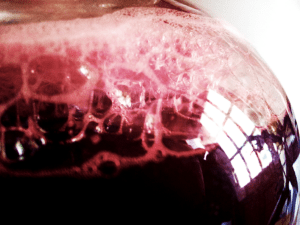 Hello,
Hello,
I am making the Strawberry Zinfandel Niagara Mist, for the first time. I have it in secondary fermentation now. It has 4 more days [before bottling] according to the directions. My question is, how do you know if it’s done? I’m using the glass S shape airlock, but very rarely have seen any bubbles since early the first day. Please help.
Thank you.
Jane
———-
Dear Jane,
It is important to realize that typically 80% of the fermentation activity will be over around the 3rd or 4th day of fermentation. After that, the activity level dramatically tapers off and the fermentation spends the rest of the time fermenting the last 20% of sugars. So, what you are experiencing is close to normal.
Having said this, the only way to really know where your fermentation stands is by testing it with a gravity hydrometer. If you do not have one, I strongly recommend you purchase one right away. As far as homemade wine equipment goes, it’s probably the most important piece you could have.
A gravity hydrometer tells you with an instant test if the wine has any sugars left in it to be fermented or if the sugars are all gone and the fermentation is complete. For more information on the subject, you may want to take a look at the article: “Getting To Know Your Hydrometer” that is on our website.
Best Wishes
Customer Service at E. C. Kraus
———————————————————————————————————
Ed Kraus is a 3rd generation home brewer/winemaker and has been an owner of E. C. Kraus since 1999. He has been helping individuals make better wine and beer for over 25 years.
Can I Mix Different Wine Concentrates Together?
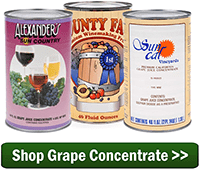 Dear Kraus,
Dear Kraus,
I would like to order Alexander’s Sun Country concentrate and blend two of the [ALC106] Zinfandel and one of the [ALC108] Barbera. I have done this with actual grapes but never with concentrate and would like to have your opinion. Using grapes the resulting wine has been rated as equal to a $40.00 bottle.
I know that I can’t have any type of guarantee as to the results, I just want to know if the 2 concentrates can be mixed and the follow the regular homemade wine instructions. I don’t want to order everything needed if you do not recommend mixing them.
Thank you,
Jerry C.
———-
Dear Jerry,
Yes, you can mix the two different wine concentrates together and then follow the homemade wine instructions for the 3 can recipe that is on our website. There will be no difference in the wine brewing process.
Having said this, one of the wine making tips you may want to consider is to make the two different wine concentrates separately, and then blend them together to taste before bottling.
This is how commercial wineries accomplish various combinations of grapes. Blending in this way gives you ultimate control of the final flavor of the wine. You can vary the ratio of the two as you see fit.
Best Wishes,
Customer Service at E. C. Kraus
———————————————————————————————————
Ed Kraus is a 3rd generation home brewer/winemaker and has been an owner of E. C. Kraus since 1999. He has been helping individuals make better wine and beer for over 25 years.
Will Your Grape Destemmer Crush My Small Grapes?
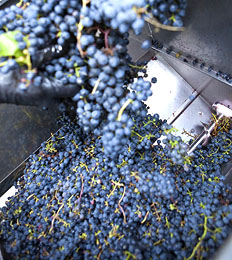 Hi,
Hi,
I have a question I hope you can help me with. It’s about the grape destemmer on your website. I would like to know if the crusher rollers on this destemmer are adjustable. I have very small grapes and need to be able to crush and destem them. They are foch grapes and this is their forth year. This is my first year for a full crop.
Thanks for your help.
Rusty C.
———-
Dear Rusty C.
While the crusher rollers on the crusher/grape destemmer are not adjustable, they are optimally set by the manufacturer. They will crush smaller grapes such as the Marechal Foch you have or Cabernet Franc among others. Grapes that are even as small as a dime are not an issue with this grape destemmer. It will also crush larger grapes such as Concord equally as well.
The picture on the right is a bottom view of the rollers and their spacing. As you can see they are very close together. The picture also shows the fluted ridges that are on each crusher roller. This makes it easy for the grapes to be grabbed by the rollers and crushed.
I hope this information helped you out. If you have any other questions please ask.
Best Wishes
Customer Service at E. C. Kraus
———————————————————————————————————
Ed Kraus is a 3rd generation home brewer/winemaker and has been an owner of E. C. Kraus since 1999. He has been helping individuals make better wine and beer for over 25 years.
My Rubber Stopper Won’t Stay In My Glass Carboy
 Dear Adventures in Homebrewing,
Dear Adventures in Homebrewing,
I hope you can help me out. I am having a problem with my 5 gallon glass carboy fermenter. I started a wine from raspberries a few days ago in my bucket fermenter. Now its time to put the wine in the carboy but the rubber stopper will not stay in the opening. It keeps coming out/coming loose. I ordered the size your company suggest. Any ideas?
Seth A.
———-
Dear Seth,
This issue can arise if there is moisture on either the stopper or your 5 gallon glass carboy. Both the side wall of the stopper and the inside of the carboy’s opening is very smooth. This smoothness is what allows the stopper to seal the carboy air-tight, but just a little bit of moisture can cause slippage, allowing the stopper to back out of the opening. This is what you are experiencing.
My suggestion is to get a paper towel and dry the stopper off completely. Then dry the inside of the carboy’s opening. Once you eliminate the moisture in these two areas, you should be able to obtain a permanent, snug fit.
If this does not solve you problem, you can try going to the next size smaller stopper, but this should not be necessary. You can also use a wire to strap down the rubber stopper. Just wrap the wire around the neck of the carboy then across the top of the stopper. Bailing wire seems to work the best for this.
I hope this helps you out.
Best Wishes,
Customer Service at E. C. Kraus
———————————————————————————————————
Ed Kraus is a 3rd generation home brewer/winemaker and has been an owner of E. C. Kraus since 1999. He has been helping individuals make better wine and beer for over 25 years.
Will My Wine Turn To Vinegar By Racking It?
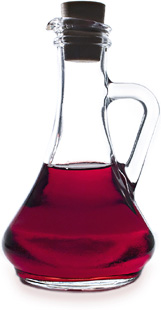 Hi,
Hi,
I have been reading that oxygen turns my wine into vinegar, so when I rack my wine doesn’t the oxygen that goes in to the fermenter hurt my wine?
Thanks Felipe
———-
[Beginner Note: Racking means to transfer a wine or must from one container to the next so as to leave any sediment behind.]
Dear Felipe,
There are two things oxygen can do to a wine. (1) It can oxidize the wine–turning it brown or orange. This is no different than an apple core turning brown. (2) It can also promote the growth of unwanted bacteria and other microbes.
Fortunately, neither one of these are an issue during the fermentation. The release of CO2 gas caused by the fermentation keeps air away from the wine. It also keep oxygen from saturating into the wine.
When the wine is done fermenting, this is when air exposure can be an issue. If the wine is racked in a splashing manor, oxygen can be saturated into the wine, replacing the CO2 gas that was once there. When this happens there is a potential for oxidative, browning effects.
There is also the potential for microbial growth, including acetobacter. This is the bacteria that produces vinegar, or more specifically acetic acid — the tart stuff of vinegar. The air invigorates the bacteria into a frenzied growth, producing more and more of the acetic acid.
Both of these detrimental scenarios can be stopped from occurring with some care and know-how. Here’s a couple of wine making tips to help keep you wine from spoiling.
- When racking the wine use a hose. Don’t pour the wine into the next fermenter. Fill the clean fermenter from the bottom up. This means the hose should reach the bottom of the fermenter and stay in the liquid. This way the wine doesn’t splash.
- Any racking that is performed after the wine brewing has completed, should be followed up with a dose of Sodium Metabisulfite being added to the wine. Sodium Metabisulfite replaces oxygen that may have gotten into the wine with SO2 gas, also known as sulfites. The sodium metabisulfite will also help to destroy any microbes that may have had a chance to call your wine home.
I hope this information helps you out. Just by doing these two simple things you can greatly improve the overall quality of your wines.
Best Wishes,
Customer Service at E. C. Kraus
———————————————————————————————————
Ed Kraus is a 3rd generation home brewer/winemaker and has been an owner of E. C. Kraus since 1999. He has been helping individuals make better wine and beer for over 25 years.
Help! My Wine Is Carbonated!
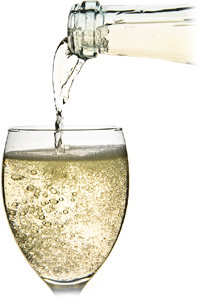 E.C.Kraus,
E.C.Kraus,
I have made some wine this year and my question is how to stop carbon dioxide from getting in the wine, And when it is in the wine how to get rid of it ?
Thank you
Dick H.
———-
Dear Dick H.
Carbon dioxide or CO2 gas is a natural byproduct of any fermentation. It’s the sparkle in a champagne. It’s the fizzy in a soda pop.
Once a fermentation has completed it is normal for CO2 to be saturated into the wine, but with the agitation involved in racking the wine, as per any homemade wine instructions, the wine should be mostly rid of the gas when it comes time to bottle.
As an added step you can also agitate the wine with a degassing paddle. It agitates the wine without splashing it or allowing air to get mixed into it. Air getting mixed into the wine at this stage would promote oxidation in the wine.
Another possibility is that the wine is fermenting in the bottles causing carbon dioxide to be created within each bottle. This can happen when the fermentation has not successfully completed before stopping. A gravity hydrometer should always be used to check that the wine has completed its fermentation before moving on to the next step.
Best Wishes,
Customer Service at E. C. Kraus
———————————————————————————————————
Ed Kraus is a 3rd generation home brewer/winemaker and has been an owner of E. C. Kraus since 1999. He has been helping individuals make better wine and beer for over 25 years.
